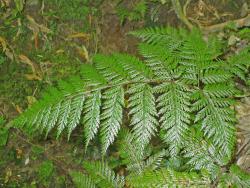Terrestrial (NZ) or rarely epiphytic ferns (not NZ). Rhizomes short- to long-creeping or rarely erect, scaly. Rhizome scales non-clathrate, linear to narrowly ovate, margins entire or toothed (NZ) or rarely spiny (not NZ), attached at base, concolorous, pale brown to almost black. Fronds monomorphic, not bulbiferous. Stipes and rachises scaly, often hairy, adaxially sulcate, not bulbiferous. Hairs usually long, predominantly acicular or clavate. Laminae 3–5-pinnate (NZ), or sometimes 1–2-pinnate (not NZ), catadromous or anadromous, herbaceous, scaly, hairy (NZ) or rarely glabrous (not NZ), usually with unicellular glands. Veins free (NZ) or rarely anastomosing (not NZ). Sori round, borne on abaxial surface, away from the margin (NZ) or rarely submarginal (not NZ), in 1 row either side of midrib; indusia reniform, peltate (NZ), or rarely absent (not NZ). Spores monolete; perispores rugose, tuberculate or echinate, sometimes minutely echinate on the surface.
A genus of c. 18 species (Gardner et al. 2017), included in the subfamily Elaphoglossoideae (PPG 1 2016).
Lastreopsis was revised by Tindale (1965). She recognised a total of 33 species, of which 17 occurred in Australia alone (Green 1994; Jones 1998). However, the genus has since been identified as paraphyletic, and subsequently split into two, with 18 species retained in a monophyletic Lastreopsis sens. str., 31 recognised in Parapolystichum, and four still incertae sedis (Labiak et al. 2014, 2015b; Gardner et al. 2017). Lastreopsis, as circumscribed by Labiak et al. (2014, 2015b), includes the Australian species previously recognised in Coveniella and Oenotrichia (Jones 1998; Brownsey 1998). However, Labiak et al. (2014, 2015b) were unable to find any morphological characters to distinguish Lastreopsis from Parapolystichum.
Even in its more restricted sense, Lastreopsis remains heterogeneous. A group of four species, including L. amplissima (C.Presl) Tindale, L. davalliodies (Brack.) Tindale, L. hispida, and L. killipii (C.Chr. & Maxon) Tindale has been segregated into subg. Rhopalotricha (Labiak et al. 2015a). This subgenus is supported by molecular data and distinguished by clavate and glandular hairs on the adaxial surface of the rachis and costae, denticulate rhizome scales, and finely echinate surfaces on the perispores. Another small clade was recognised by Gardner et al. (2017) that included L. vieillardii (Mett.) Tindale and another taxon from New Caledonia, now described as L. abscondita Perrie & Amice (Perrie et al. 2021). These two taxa are distinguished from the others by their molecular data and by almost hairless adaxial lamina surfaces. The inter-relationships among these subgroups require further investigation. Even when subgenus Rhopalotricha and L. vieillardii and L. abscondita are put to one side, although the remaining Lastreopsis species are a more homogeneous group, there is still no morphological synapomorphy to distinguish them from Parapolystichum. Lastreopsis is treated here in the broader sense of Labiak et al. (2014).
The two species of Lastreopsis present in New Zealand, L. hispida and L. velutina, are atypical of the group as a whole. Even within subg. Rhopalotricha, L. hispida is unusual in having bulbous-based, bristle-like scales on the stipes and rachises that are not seen in any other species. Similarly, L. velutina is distinctive within subg. Lastreopsis in having an erect rather than creeping rhizome, and abundant acicular rather than catenate hairs on all lamina surfaces.
Allan (1961) initially treated Lastreopsis hispida in Rumohra, and L. velutina in Ctenitis but, following Tindale (1957), he accepted both in Lastreopsis (Allan 1961, Supplementary Notes).
Currently no morphological characters are known that consistently distinguish Lastreopsis from Parapolystichum, and the two genera cannot always be recognised as such in the field. However, the two New Zealand species of Lastreopsis are very distinctive and are easily identified individually. L. hispida has bulbous-based, bristle-like scales on the stipes and rachises that are not present in any other species, and L. velutina has a dense covering of soft, acicular hairs on all surfaces of the laminae that gives the frond a velvety feel.
In the wider Australasian region, species of Lastreopsis subg. Lastreopsis generally have short- to long-creeping rhizomes (although not in L. velutina), laminae that are mostly 3–4-pinnate and catadromous in the distal half, and sori that are more frequently indusiate. Most importantly, they generally have long, acicular or clavate hairs, rather than short, catenate (ctenitoid) hairs on the lamina and rachis surfaces. By contrast, species of Parapolystichum have erect to long-creeping rhizomes, laminae that are 2–4-pinnate and anadromous in the distal half, and sori that may be indusiate or exindusiate. They have short, catenate (ctenitoid) hairs on the lamina and rachis surfaces, rather than long, acicular or clavate hairs.
Lastreopsis extends from the Neotropics to India, Sri Lanka, south-east Asia, Australia, New Zealand and the south-west Pacific, with the centre of diversity in Australia; two species in South America, one in India and Malesia, 11 species in Australia, four in New Caledonia, and two in the Pacific. However, subg. Lastreopsis is absent from the Neotropics (Tindale 1965; Labiak et al. 2014, 2015b; Gardner et al. 2017). Two species in New Zealand; one endemic.
| Category | Number |
|---|---|
| Indigenous (Endemic) | 1 |
| Indigenous (Non-endemic) | 1 |
| Total | 2 |
The base chromosome number in Lastreopsis is x = 41 (Tindale & Roy 2002).




